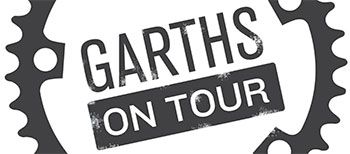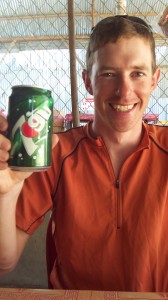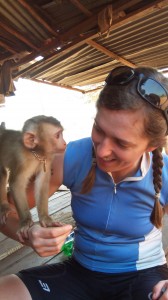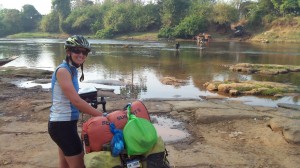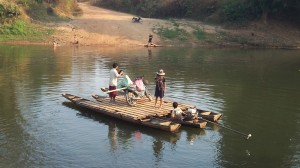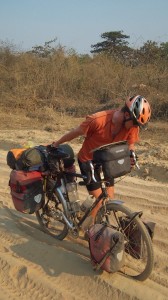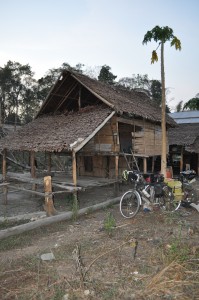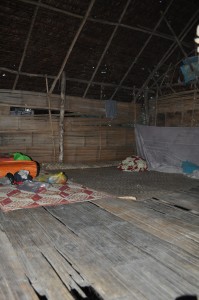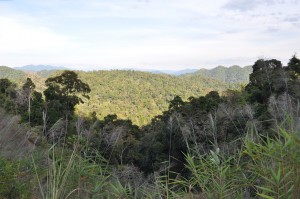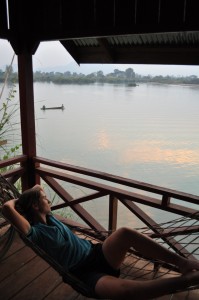The summary of a single day of cycling in this country:
February 22, 2013
We woke up early… we knew we had to. Riding needed to happen as early as possible in the day. So we rose to the sound of the alarm at 4:15, hoping to pack up and hit the road as soon as the sun began to light up the sky.
Laos is a HOT country, and we have managed to work our way into the hottest time of the year in Southeast Asia. We’ll likely be feeling the heat for the next two months here. But Laos, with its steep climbs and mountainous terrain, was the first country where we began to experience the intensity of the heat. Fortunately, the day before, we seemed to have come out of the mountains, so we were hoping for more of the flat lands on this day, where we could at least ride fast enough to get a breeze on our faces.
We were on the road around 6:30, after our morning routine of cooking, eating, washing the dishes, packing, carrying our bags downstairs and stretching. We cycled on the main road out of Attapeu, headed west toward the tourist destination of Four Thousand Islands. About three kilometers out of town, we turned left on the road that would be the most direct route, and were instantly disappointed to see the pavement replaced with red dirt and loose gravel. A dirt road… usually slower and undoubtedly dirtier, it would be our companion for the next 120 kilometers.
Around 9:30 a.m., we stop for our first “cold drink break,” which was a daily ritual in Laos. Every morning and every afternoon we would stop to buy cold beverages from small stores that lined the road. It helped us to drink something besides our water, both for the calories, and because the water in our bottles was unpleasantly warm by mid-morning anyway.
Now, usually we try to make the first break relatively short, as it’s not miserably hot yet by that time. But on this particular day, as we were getting ready to go, a boy from across the street decided to come over with his pet monkey. That’s right. Apparently that’s normal in Laos. The monkey was on a leash and everything! Completely fascinated by this, we stuck around a little longer to make friends with this curious creature.
After our morning break, we pressed on another 10 kilometers, only to stop again for lunch because we were in the last town that was indicated on our map… and we certainly didn’t want to miss our opportunity to eat! All we could find was hot noodle soup. It is still a mystery to us how people who live in this kind of heat can eat so much piping hot soup as a part of their diet. But beggars cannot be choosers, so we ate what was available before pressing on in the afternoon sun.
Another hour passed and it was time for another cold drink break. The road conditions had worsened a bit, and we kept stopping to confirm our route by pointing at our map and asking for the next town (which we knew would be about 80 kilometers). We stopped in a small village where we found one woman selling refrigerated drinks. We sat in her shade for nearly an hour before setting out again, and by this time the afternoon heat was beginning to wear off just a little.
We weren’t quite expecting what happened next. We had confirmed our direction before leaving the store, and everyone pointed us straight ahead on the road. But when we followed their leading, we found ourselves facing a river–quite a wide river–with no bridge. We watched as a few random people wandered across on foot, with water up to their knees. Hmmm… we stared for a little while, formulating our action plan for crossing.
Just then a few other people spotted us and pointed around, as if to indicate that if we went a little farther downstream, maybe there was a bridge or ferry or something. We decided it was worth checking out, so we backtracked and followed the road a few hundred meters until it met the river once again. This time, we saw the “ferry”–what looked like a few boards atop three canoes all strapped together, with a small motor on the back. “We’ll take it!” we said, just happy to not have the hassle of maneuvering our bikes across the river.
After the river crossing, road quality declined quickly. Obviously this part wasn’t as heavily trafficked, since the river we came over didn’t even have a bridge. We saw only a few other vehicles–mostly motorcycles and one truck. The road was no longer solid, but turned to a fine, dusty sand into which our tires sunk deeply.
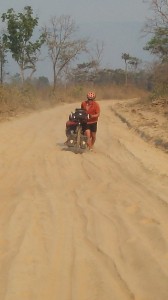
At times, the sand was too deep to stay upright. Unfortunately, pushing the bikes wasn’t much easier.
Along with the decline in road quality, the terrain suddenly became hilly. These were no mountains, but they were hills enough to be a real pain when sandy. We’d ride as fast as we could on the down before creeping to a stop halfway up the next one… then pushing the rest. The dust was everywhere–our chains were noisy with all the dirt caked in every link, and shifting gears became a squeaky affair. By now it was getting late in the day, and though we’d only done about 50K, we knew it would be time to stop soon. We had everything we needed to camp, including extra water we’d collected from the river. But this road was a bit desolate and almost creepy, and I kept hoping to find a village or somewhere we could camp near people.
Around 5 p.m., we saw a cluster of bamboo houses off the road to the right. We decided to give it a go, and rolled our bikes through the field of dry grass between the road and the houses. It appeared that a family lived there, and the man we assume was the father (we’ll call him “dad” from here on), came out to meet us. We tried to ask if we could camp by pulling out a picture of our tent and pointing to the place we thought we could pitch it nearby. Dad looked at us, a little baffled, but motioned us to come in. He stopped at the first bamboo hut on stilts, climbed up the ladder, and indicated to us that we could sleep in there if we wanted. What?! We surveyed the offer–straw mats on the uneven bamboo floor wouldn’t be so bad with our sleeping pads on top. But the mosquito net had massive holes in it, and we knew we were in a malaria risk zone. After a brief discussion, we decided we could pitch the tent inside if necessary, but seriously… how often would we be able to sleep in a bamboo tree-house in Laos? Probably something we should take advantage of.
We were so thankful for dad’s kindness to open up his “guest room” to us for the night. As evening fell, we pulled out our stove to cook dinner, but just as we started, dad brought over a tray with sticky rice and a single grilled fish–sharing the family meal with a couple of strangers. He also brought us a bucket full of water (of course there was no running water) and a battery-powered light (of course there was no power either). Wow… here we were, in the middle of nowhere, Laos, and this family was showing such generosity and hospitality to us. We went to sleep that night–a clear night with a beautiful, unpolluted view of the stars–grateful once again for God’s provision and for another day of riding our bicycles.
Before and after:
We only got to spend one week in Laos, but here are a couple of shots that show what we saw before and after this highlight day. Oh, and as a side note, don’t you know that the next morning we woke up and had to cross FOUR MORE RIVERS without bridges before the road got any better? Laos–one of a kind.
